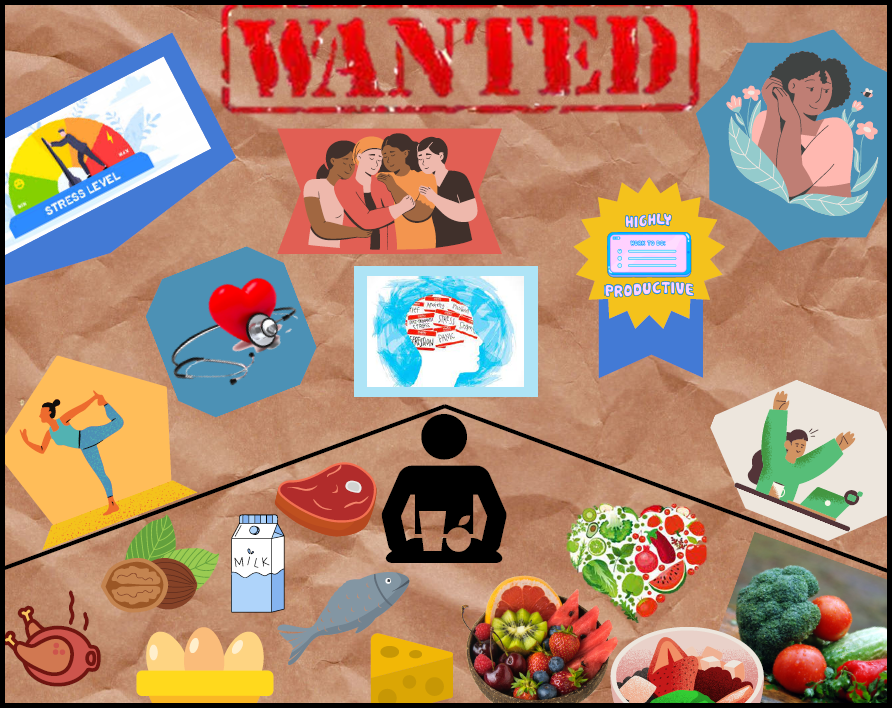19 Food Justice

By Tracey Webster
The social justice issue I decided to focus on for my digital collage is food justice, specifically food insecurity for adults in the workplace. “Food insecurity is defined as inadequate or insufficient access to food due to financial constraints” (TEDx Talks, 2021, 2:13). I selected this topic based on my current work experience. At my organization, our CEO subsidizes the cost of food in the cafeteria to ensure that all employees have access to healthy food at work.
The belief is that there is a direct correlation between healthy food and its impact on the body and mind. It helps create a healthier, more productive, happier, less stressed employee with increased mental health (Canadian Centre for Occupational Health and Safety, 2020). Unfortunately, only some organizations share this philosophy.
As I depicted in my digital collage, many additional benefits can result from having access to healthier foods. Studies showed that 65% of food-insecure households were in the workforce, so more organizations need to implement similar programs (Tarasuk & Mitchell, 2020). The Wanted title at the top of the collage represents the deficiency we are currently encountering within organizations. Additionally, it is not enough that people have access to sustenance, as true food security means that “people have enough high-quality, protein-rich, safe food to eat” (UFCW Canada, n.d., para. 3). Therefore, the selected images characterize the foods that should be readily available. I also attempted to illustrate that food insecurity is unfairly more common in Black and Indigenous communities (TEDx Talks, 2021, 4:33). With multicultural images, I show that food security should be available to all ethnicities. Considering that employees with unhealthy eating habits are 66% more likely to be unproductive, it is advantageous for organizations to encourage employees to make healthier choices (Gonzalez, n.d.). Following my organization’s leadership and providing employees with healthier choices at a reduced or subsidized rate ensures they have access to at least one healthy meal daily.
References
Canadian Centre for Occupational Health and Safety. (2020, May 21). Healthy eating at work. Government of Canada. https://www.ccohs.ca/oshanswers/psychosocial/healthyeating.html
Gonzalez, R. (n.d.). Employee nutrition – The biting impact on your bottom line. Corporate Wellness Magazine. https://www.corporatewellnessmagazine.com/article/the-biting-impact-of-employee-food-choices-on-your-bottom-line-2
Tarasuk, V., Dachner, N., Hamelin, A.-M., Ostry, A., Williams, P., Bosckei, E., Poland, B., & Raine, K. (2014). A survey of food bank operations in five Canadian cities. BMC Public Health, 14, 1234. https://doi.org/10.1186/1471-2458-14-1234
Tarasuk, V. & Mitchell, A. (2020) Household food insecurity in Canada, 2017-18. Toronto: Research to identify policy options to reduce food insecurity (PROOF). Retrieved from https://proof.utoronto.ca/
TEDx Talks. (2021, January 4). What we get wrong when we think about food insecurity | Leslie Campbell | TEDxYouth@PCI. [Video]. YouTube. https://www.youtube.com/watch?v=pLJ3XnTMlRMUFCW Canada.
UFCW Canada. (n.d.). Food justice. UFCW Canada – Canada’s Private Sector Union. https://ufcw.ca/index.php?option=com_content&view=article&id=32010:food-justice&catid=9978:food-justice&Itemid=2383&lang=en

